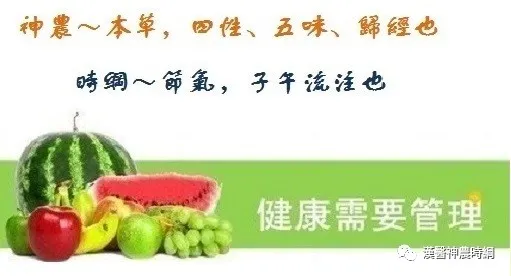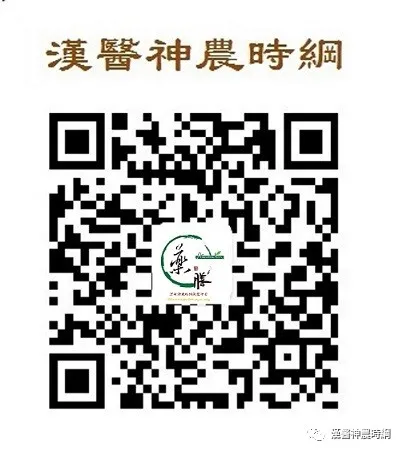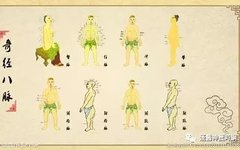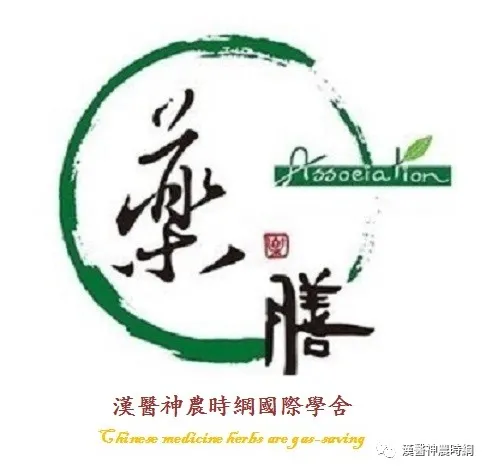
What are the Extraordinary Eight Meridians?
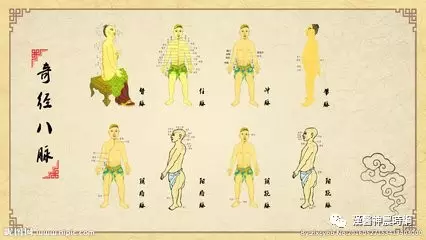
The Extraordinary Eight Meridians refer to the Du Mai (Governing Vessel), Ren Mai (Conception Vessel), Chong Mai (Penetrating Vessel), Da Mai (Belt Vessel), Yang Wei Mai (Yang Linking Vessel), Yin Wei Mai (Yin Linking Vessel), Yin Qiao Mai (Yin Heel Vessel), and Yang Qiao Mai (Yang Heel Vessel). Unlike the twelve regular meridians, they do not directly connect to the organs and do not have a paired relationship, hence they are called “extraordinary meridians”.Their functions include:
1. Connecting the relationships between the twelve meridians;
2. Regulating the accumulation and distribution of Qi and blood in the twelve meridians.
The Eight Meridians
The Ren Mai runs along the midline of the abdomen and intersects multiple times with the three Yin meridians of the hands and feet as well as the Yin Wei Mai, thus it is known as the “Sea of Yin Meridians”. The Ren Mai originates from the uterus and is related to women’s pregnancy, hence it is said to “govern the uterus and fetus”.
The Du Mai runs along the midline of the back and intersects multiple times with the three Yang meridians of the hands and feet as well as the Yang Wei Mai, thus it is known as the “Sea of Yang Meridians”. The Du Mai runs along the spine, ascends into the brain, and branches out to the kidneys, establishing a close relationship with the brain, spinal cord, and kidneys.
The Chong Mai extends from the head to the feet, traversing the entire body; it serves as a crucial point for Qi and blood, regulating the Qi and blood of the twelve meridians, hence it is called the “Sea of the Twelve Meridians” or “Sea of Blood”. It is also related to women’s menstruation.
The Da Mai originates from the lateral costal region, slants downward to the Da Mai point, encircling the body like a belt, and can restrain the meridians running vertically.
The Yin Qiao Mai and Yang Qiao Mai: “Qiao” implies agility and lightness. They nourish the eyes, control the opening and closing of the eyelids, and facilitate lower limb movement.
The Yin Wei Mai and Yang Wei Mai: “Wei” implies connection. The function of the Yin Wei Mai is to “connect all Yin meridians”; the function of the Yang Wei Mai is to “connect all Yang meridians”.
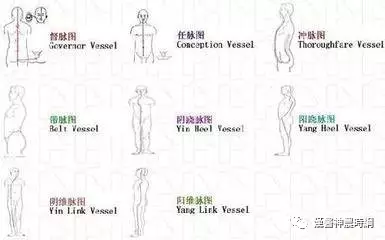
The Extraordinary Eight Meridians intricately circulate and distribute between the twelve meridians, and their functions are primarily reflected in two aspects.
Firstly, they connect the relationships between the twelve meridians. The Extraordinary Eight Meridians link meridians that are close in location and similar in function, achieving the effect of regulating the Qi and blood of related meridians and coordinating Yin and Yang. The Du Mai connects with the six Yang meridians, known as the “Sea of Yang Meridians”, which regulates the Qi of all Yang meridians; the Ren Mai connects with the six Yin meridians, known as the “Sea of Yin Meridians”, which regulates the Qi of all Yin meridians; the Chong Mai connects with the Ren and Du meridians, as well as the Yangming and Shaoyin meridians, hence it is called the “Sea of the Twelve Meridians” or “Sea of Blood”, which has the function of storing the Qi and blood of the twelve meridians; the Da Mai restrains and connects the various foot meridians running vertically; the Yin and Yang Wei Mai connect the Yin and Yang meridians, respectively governing the exterior and interior of the body; the Yin and Yang Qiao Mai govern the movement of Yang and the stillness of Yin, coordinating lower limb movement and sleep.
Secondly, the Extraordinary Eight Meridians regulate the accumulation and distribution of Qi and blood in the twelve meridians. When the Qi and blood of the twelve meridians and organs are abundant, the Extraordinary Eight Meridians can store them; when the body’s functional activities require it, the Extraordinary Eight Meridians can also distribute and supply them.
The Chong, Da, Qiao, and Wei meridians all attach to the twelve meridians and the Ren and Du meridians, but the Ren and Du meridians each have their own associated acupoints, thus they are collectively referred to as the “Fourteen Meridians”. The Fourteen Meridians have specific circulation routes, symptoms, and associated acupoints, forming a major part of the meridian system, which serves as the foundation for acupuncture treatment and the application of herbs in clinical practice.
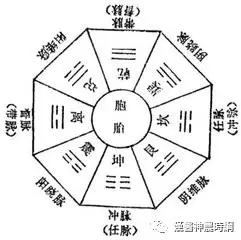
The Extraordinary Eight Meridians regulate the accumulation and distribution of Qi and blood in the twelve meridians. Among the Eight Meridians, there are eight representative acupoints: Gong Sun (Gong Sun), Nei Guan (Inner Pass), Lin Qi (Palace of Tears), Wai Guan (Outer Pass), Shen Mai (Shen Pulse), Hou Xi (Back Stream), Lie Que (Broken Sequence), and Zhao Hai (Shining Sea).
Each acupoint is akin to a “nuclear reactor”, treating a large area at once.
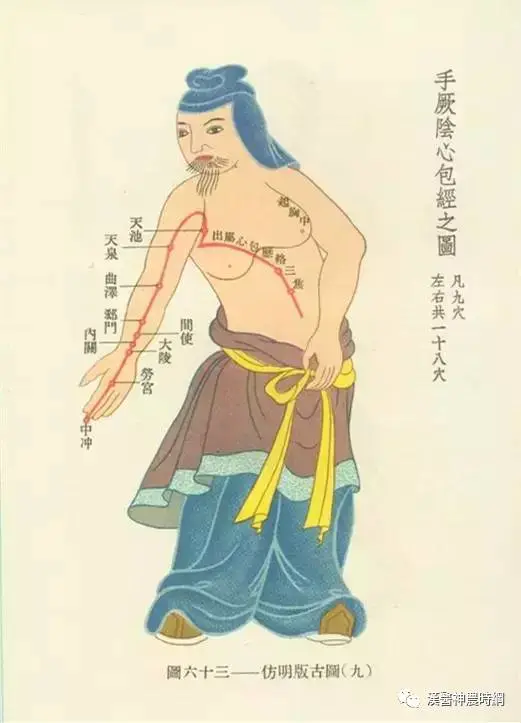
1. Nei Guan: Nourishing the Heart and Beauty
Many women between the ages of 40 and 50 often experience symptoms such as palpitations, shortness of breath, and spontaneous sweating. Hospitals may not find any specific illness, only broadly diagnosing it as menopausal syndrome or sub-health.
In fact, according to ancient wisdom, when women reach this age, their bodies are generally in a state of decline, with aging starting from the Yangming meridian, gradually leading to a decline in the Qi and blood of the three Yang meridians. The head is the meeting point of all Yang, and when Qi and blood cannot reach the face, wrinkles and spots appear. A person’s beauty is closely related to Qi and blood. The heart governs the spirit, and its radiance is reflected on the face. The spirit of the heart relies on Qi and blood for nourishment; when Qi and blood are abundant, it naturally reflects on the face. Therefore, for women, nourishing beauty begins with nourishing the heart.
The Nei Guan acupoint belongs to the Pericardium meridian, connects with the Ren Mai, and is one of the Eight Meridians’ intersection points. The true efficacy of the Nei Guan acupoint lies in its ability to open the body’s internal mechanisms, benefiting Qi and blood, calming the spirit, and enhancing beauty. The Nei Guan acupoint is easy to locate, situated two inches above the wrist crease on the inner side of the arm. When locating the acupoint, make a loose fist and place it palm-up; use the index, middle, and ring fingers of the other hand to align with the wrist crease, and the point where the index finger presses is the Nei Guan acupoint. The health benefits of this acupoint are that it can be pressed and rubbed at any time and place, with a slight feeling of soreness being ideal.
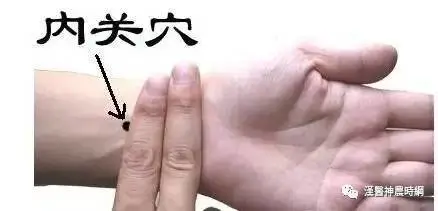
2. Wai Guan: The “Clever Ear Acupoint”
Traditional Taoist medicine believes that temporary hearing issues are manifestations of insufficient Yang Qi in the body. So what role does the Wai Guan acupoint play at this moment? Massaging the Wai Guan acupoint can enrich the Yuan Yang Qi of the San Jiao and guide the Yuan Qi to circulate throughout the body. When this acupoint is blocked, it can cause the eardrum to become slack and unable to return to its normal state.
Clinically, the Wai Guan acupoint can also be used to treat acute lumbar sprains. A patient around 40 years old once bent down to pick something up and suddenly could not move his waist; any slight movement caused unbearable pain. After treatment with acupuncture and massage, the pain completely disappeared after a few minutes of stimulating the Wai Guan acupoint while allowing him to perform gentle twisting movements of the waist. The Wai Guan acupoint is a Luo point of the San Jiao meridian, located two inches above the wrist crease on the back of the wrist, opposite the Nei Guan acupoint. The Wai Guan connects with the Yang Wei acupoint, having the effects of dispelling exterior pathogens, relieving wind, and alleviating pain. It is not only effective for acute lumbar sprains but also has good effects on arthritis and cervical spondylosis.
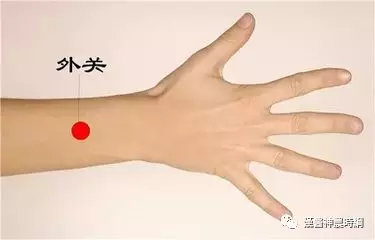
3. Lie Que: Special Treatment for Stiff Neck and Migraine
Stiff neck is an experience almost everyone has gone through, often causing great discomfort. A stiff neck can also be an early signal of cervical spine issues; those who frequently experience stiff necks may develop cervical spondylosis if not properly managed. The Lie Que acupoint has unique effects in preventing cervical spondylosis. On the human body, the Lie Que acupoint serves as a tool for repairing head-related ailments.
The Huang Di Nei Jing records that the Lie Que acupoint primarily treats migraines, headaches, and stiff necks. In the Zhen Jiu Da Cheng, there is a well-known verse about the four major acupoints, one of which states: “For neck ailments, seek Lie Que.” This means that any issues above the neck can be treated and adjusted using this acupoint. The Lie Que acupoint is easy to locate, situated 1.5 inches above the wrist crease on the radial side of the wrist. When locating the acupoint, cross the thumbs of both hands, and the depression reached by the fingertips is the acupoint. The technique for using the Lie Que acupoint mainly involves flicking.
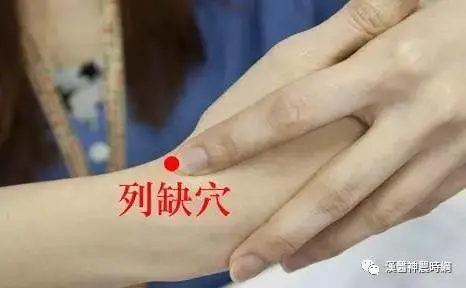
4. Hou Xi: Treatment for Cervical and Lumbar Diseases
How to locate the Hou Xi acupoint? Make a fist, and the acupoint is located at the distal end of the transverse wrist crease behind the fifth finger joint (i.e., the end of the transverse crease when the fist is made).
If you are sitting in front of a computer, you can place the Hou Xi acupoint on the edge of the table, using the wrist joint to roll your hands back and forth easily to achieve a stimulating effect. During the rolling, there will be a slight feeling of soreness. Just take three to five minutes each day to do this, and it will have very good effects on the cervical and lumbar spine.

5. Zhao Hai: Treatment for Throat Pain
Pressing the Zhao Hai acupoint can have excellent effects for sore throats, as it belongs to the Yin Qiao Mai and intersects with the Shaoyin Kidney meridian, being one of the key intersection points of the Eight Meridians. It has the functions of nourishing the kidneys, clearing heat, and regulating the San Jiao, providing both nourishment and heat-clearing effects.
Sun Simiao in the Qian Jin Yao Fang referred to this acupoint as “Luo Yin”, meaning that if there is an issue with this acupoint, the body’s kidney water decreases, leading to kidney Yin deficiency and causing deficiency heat to rise. Therefore, whenever we feel discomfort in the chest, dry throat, hoarseness, or even chronic pharyngitis, we can press this acupoint, which has the effects of nourishing the kidneys and clearing heat, while also ensuring smooth function of the San Jiao.
To locate the acupoint, align the soles of both feet, and there is a small depression below the inner ankle, which is where the acupoint is located (see the image above). When massaging this acupoint, one should keep their mouth closed and refrain from speaking, feeling the emergence of saliva in the mouth, which should be swallowed down. Generally, after pressing for 3 to 5 minutes, one will feel saliva in the throat, and the pain will immediately alleviate. Keeping the mouth closed is to facilitate the upward movement of the saliva to moisten the throat, which is what the ancients referred to as the “swallowing saliva method”. Massaging the Zhao Hai acupoint stimulates the essence in the kidneys, promoting the upward movement of fluids to moisten the throat, and the deficiency heat is nourished by the kidney water, thus alleviating throat pain naturally.
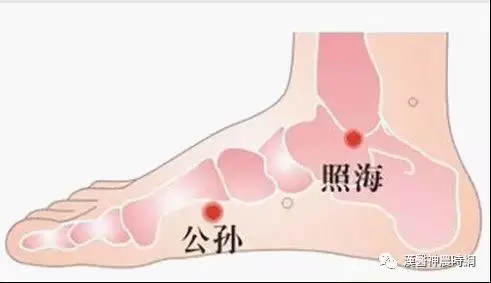
6. Shen Mai: A Pure Yang Remedy for Cold Bodies
“Stiffness in the waist and back, leg pain” is a clear sign of the bladder meridian being affected by cold evil Qi. Since the Yang Qiao connects with the bladder meridian, the Shen Mai acupoint is an important point of the bladder meridian. Therefore, the Shen Mai acupoint is the purest Yang, and using this acupoint can dispel internal cold evil and allow Yang Qi to reach the top of the head, balancing the body and enabling agile movement.
When combined with Xiao Qing Long Tang (Minor Blue Dragon Decoction), it achieves a synergistic effect of resolving exterior and interior simultaneously. This allows the cold evil in the patient’s body to be expelled quickly while restoring their Yang Qi, making it a miraculous acupoint for dispelling cold and reviving Yang.
The Shen Mai acupoint is an important intersection point of the Yang Qiao and the Taiyang bladder meridian, and its location is also very simple, found in the depression directly below the outer ankle bone. When the body is affected by cold evil, it tends to curl up and shiver, which in TCM is referred to as “contraction and pulling in”; the Shen Mai acupoint has the meaning of extending the meridians, quickly mobilizing the body’s Yang Qi, and when Yang Qi is sufficient, the cold evil will disperse.
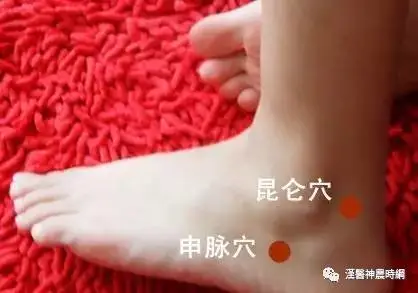
7. Gong Sun: Alleviating Dysmenorrhea and Spleen-Stomach Disorders
Gong Sun is the Luo point of the Spleen meridian, belonging to the spleen and connecting with the stomach, and it directly communicates with the Chong Mai located in the abdominal area, thus it has the function of treating various disorders of the spleen, stomach, and abdominal area.
Medicine believes that treating all gynecological diseases should start from the spleen and stomach, especially for menstrual irregularities, where the stomach should be adjusted first. The spleen governs blood and is responsible for transformation. If the spleen and stomach are deficient and cold, they cannot transform and transport fluids, leading to dysmenorrhea, which may also be accompanied by symptoms such as vomiting, nausea, and headaches.
Women with dysmenorrhea can frequently press the Gong Sun acupoint. The Gong Sun acupoint is located on the inner edge of the foot; I generally consider the Gong Sun acupoint as a region, located behind the big toe, where there is a large metatarsal bone. Press along the inner side of this bone until you reach the point of maximum soreness or discomfort, which is your own Gong Sun acupoint.
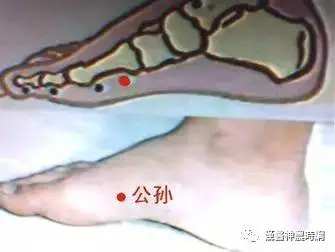
8. Lin Qi: Elevating the Body’s Shaoyang Qi
The Lin Qi acupoint is one of the main acupoints on the Gallbladder meridian, connecting with the Da Mai, and it is a wonderful acupoint that can adjust one acupoint while regulating two meridians. The Da Mai runs around the navel, like a jade belt tied around the center of the body, restraining the vertical meridians and enhancing the connection of Qi and blood flow between the meridians, making it a very important health meridian for the body. When using this acupoint, a sitting position with bent legs can be adopted; it is located on the outer side of the foot, in the gap between the fourth and fifth toes. The Lin Qi acupoint primarily elevates the body’s Shaoyang Qi and disperses the Qi stagnation of the liver and gallbladder. Regular pressing can yield better results than professional foot therapy.
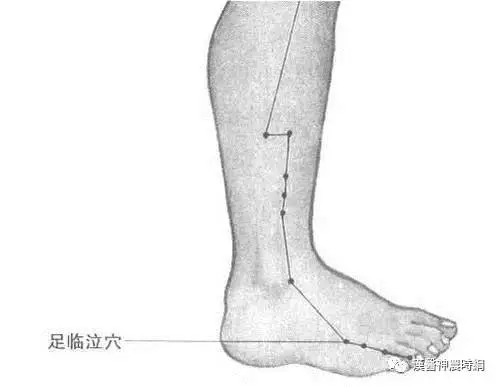
The Eight Acupoint Song
Among the Eight Meridians, there are eight representative acupoints: Gong Sun, Nei Guan, Lin Qi, Wai Guan, Shen Mai, Hou Xi, Lie Que, and Zhao Hai. An ancient song about the “Eight Acupoints” has been passed down:
Gong Sun connects the Chong Mai, stomach, heart, and chest,
Nei Guan connects with the Yin Wei, governing all below;
Lin Qi connects the Gallbladder and the Da Mai,
Yang Wei sharpens the eyes, while Wai Guan meets;
Hou Xi connects with the Du Mai and the inner canthus of the neck,
Shen Mai connects with the Yang Qiao and is also linked;
Lie Que connects with the Ren Mai and the lung system,
Yin Qiao and Zhao Hai govern the throat and the lungs.
